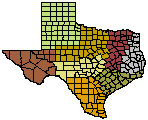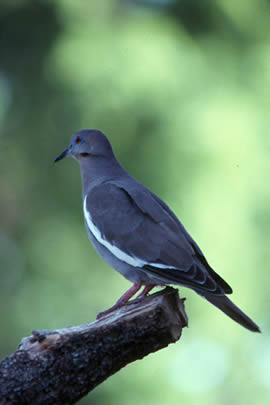- Trans Pecos
- High Plains/Panhandle
- Cross Timbers
- Hill Country
- Post Oak Savannah
- Pineywoods
- Oak Prairie
- South Texas Plains

Wildlife Division District Map
South Texas Wildlife Management
White-winged Doves
 Biology
Biology
The white-winged dove (Zenaida asiatica) closely resembles the slightly smaller, grayish-brown mourning dove. Its name is derived from the noticeable white-marked feathers on the upper wing surface. The tail is shorter compared to wing length, and more bluntly or rounded when compared to the mourning doves' long, pointed tail. The call of the white-winged dove is distinctive with loud a loud cooing sequence that sounds like "who cooks for you" with emphasis on the last note. They are colonial nesters and also congregate while roosting and during feeding activities.
Since the early 1930's, the white-winged dove has been an important game
bird for many generations of Texas hunters in the Lower Rio Grande Valley
(LRGV). Following the introduction of irrigation and grain farming to the
LRGV in the early 1900's, the white-winged dove population increased to an
estimated 4-12 million birds by 1923. However, due to the continued loss
of native habitat that was being put into farming the population declined
to about 500,000 birds by 1939. The destruction of 90% of its critical nesting
habitat through intensive agricultural farming and heavy hunting in the 1920's
and 1930's contributed to this decline. The average number of hunters that
traditionally traveled to the LRGV was 35,000-40,0000 each year.
Distribution
Historically, the white-winged dove has nested primarily in the LRGV with their distribution apparently restricted to the sub-tropical to temperate environment that reaches its northern limit here. Within the last 20 years however, a dramatic increase in nesting populations have increased throughout Texas and even into other states. The range expansion apparently started during the 1980's when citrus groves that had become major nesting areas for white-winged doves, were decimated with killing freezes. Many of the citrus groves were never replaced and an increasing human population in the LRGV has caused additional loss of habitat through development.
Cottam and Trefethan (1968) reported in their book "Whitewings", only small outlying white-winged dove populations as far west as Val Verde, Kinney, Uvalde counties and as far east as Atascosa, Wilson, Karnes, Bee, Goliad and Refugio counties. San Antonio was not mentioned in this data. These areas supported small numbers of widely scattered breeding birds. While some nesting has historically occurred in the cities and towns of upper south Texas (about 5%) where mature shade tree survived, "there was little pioneering by the doves into other towns where the original nest trees were destroyed, even though planted shade trees have developed into what appears to be good nesting cover" (Cottom and Trefethan, 1968). There was some fringe nesting that occurred in the Balcones Escarpment, the break between the Edwards plateau and the Rio Grande plains but it contributes little to the total annual production (Cottam and Trefethan, 1968).
Population Characteristics
While Texas Parks and Wildlife (TPW) have been monitoring white-winged dove populations since 1951, an intensive survey was conducted in 1989 and 1990 throughout south Texas to determine the extent of this expansion and the population of nesting white-wings outside of the LRGV. Several techniques were used including rural coo counts, urban coo counts and fall flight counts.
Results of these rural coo counts indicated many white-winged doves were nesting in the breaks of the Edwards plateau in the area of northern Uvalde, Kinney and Medina counties with a substantial number of nesting pairs in the vicinity of Medina lake and the Concan area of Uvalde county. The area around Lake Corpus Christi showed a steady increase in nesting birds also. There was very little nesting activity in the typical south Texas chaparral, due to the lack of tall mature trees. The cities and towns scattered throughout south Texas have extensive nesting occurring with the greatest activity in the cities of San Antonio, Del Rio, Uvalde, Beeville and Alice. Currently, white-winged dove surveys are conducted in numerous cities and towns throughout Texas.
The 2000 spring breeding survey revealed an estimated 507,335 white-wings in the LRGV and 720,000 in upper south Texas. The term upper south Texas includes all counties located outside the LRGV and within the south Texas ecological area. Of the 507,335 birds in the LRGV, less than 8% utilized citrus trees for nesting while 92% used native brush and urban areas. This was the tenth year in the last eleven that the numbers of white-winged doves in upper south Texas exceeded the number of counted in the LRGV. Outside of the south Texas ecological region, Travis County in central Texas had 264,000 birds and west Texas had an estimated population of 33,150. Again, the majority of nesting occurs within the cities. The nesting white-winged doves seem to prefer the older more established residential neighborhoods with large live oak, pecan, and ashe trees. This may be due to better protection from predators and a consistent food and water sources due to watering of lawns and bird feeders.
Hunting
Know Your Doves | PDF
Hunting the white-winged dove continues to be a desired recreational sport. Due to continued hunting pressures and loss of habitat in the LRGV, TPW initiated a sanctuary system in 1978 that alternated hunting areas along the Rio Grande River by years to keep from over harvesting certain areas. In 1999 an estimated 607,000 white-wings were harvested in Texas. Approximately 50,700 white-winged doves were bagged in upper south Texas compared to 44,400 in the LRGV. The special white-winged dove season in the LRGV consists of two weekends with shooting hours from noon to sunset. It is advisable to read the regulations to regarding white-winged dove hunting and determine the hunting areas.
Once this is established, farms with grain or corn stubble, sunflowers, or sesame are the best areas. Also, look for watering areas and roosting trees in the vicinity. If unfamiliar, there are numerous outfitters, guides and even local farmers that advertise white-wing hunting. The LRGV chambers of commerce's are excellent sources of information. In the remaining area of south Texas, white-winged doves are concentrated around the urban areas and towns. Generally, the majority of white-wings are harvested in conjunction with mourning dove season and are incidental or bonuses in the bag. Hunting in close proximity of San Antonio, Uvalde, Del Rio, Beeville, Mathis, will usually increase the numbers of birds. As the white-winged dove population continues to expand and increase throughout south Texas it is obvious that the numbers of birds harvested will also increase, thus giving more recreation for south Texas sportsmen.